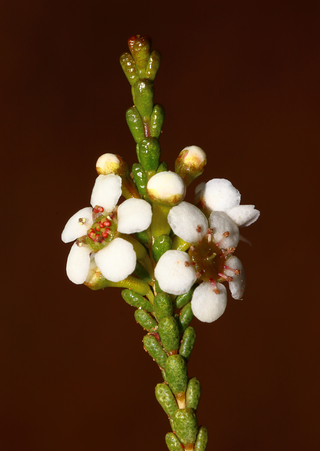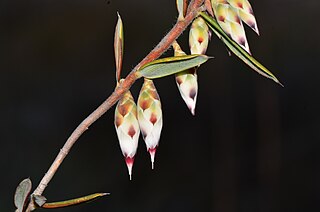
Eremophila recurva is a flowering plant in the figwort family, Scrophulariaceae and is endemic to Australia. It is a shrub with hairy grey leaves, large grey sepals and blue, mauve or lilac flowers.

Calytrix acutifolia is a species of flowering plant in the myrtle family Myrtaceae and is endemic to south-west of Western Australia. It is a slender, openly-branched shrub with linear to lance-shaped leaves and clusters of white, cream-coloured or yellow flowers with 40 to 85 white stamens in several rows.

Micromyrtus clavata is a species of flowering plant in the family Myrtaceae and is endemic to inland Western Australia. It is an erect, compact or sprawling shrub with erect, egg-shaped leaves with the narrower end towards the base and small white flowers arranged singly in upper leaf axils.
Eremophila daddii is a flowering plant in the figwort family, Scrophulariaceae and is endemic to Western Australia. It is a large shrub with sticky branches, hairy leaves and brown and cream-coloured flowers blotched with purple.
Boronia interrex, commonly known as the Regent River boronia, is a plant in the citrus family, Rutaceae and is endemic to a small area in the Kimberley region of Western Australia. It is an erect, sometimes low-lying shrub with pinnate leaves, cream-coloured to pale pink sepals and pink petals, the sepals longer and wider than the petals.
Boronia thedae, commonly known as the Theda boronia, is a plant in the citrus family, Rutaceae and is endemic to a small area in the Kimberley region of Western Australia. It is an erect shrub when young, later a prostrate shrub with many branches, pinnate leaves, four white to cream-coloured or pale pink sepals and four similarly coloured petals, the sepals longer and wider than the petals.

Conostephium hortiorum is a species of flowering plant in the family Ericaceae and is endemic to the south-west of Western Australia. It is a spreading shrub with linear, narrowly elliptic or narrowly triangular sharply-pointed leaves and pendulous, spindle-shaped, straw-coloured and dark purple flowers.
Thomasia × formosa is a species of flowering plant in the family Malvaceae and is endemic to a restricted area of the south-west of Western Australia. It is an erect, compact shrub with densely hairy branchlets, hairy, coarsely serrated, egg-shaped to elliptic or oblong leaves, and racemes of pink or purple flowers arranged in leaf axils.
Conostephium laeve is a species of flowering plant in the family Ericaceae and is endemic to the west of Western Australia. It is a compact shrub with erect, narrowly elliptic or narrowly egg-shaped leaves with the narrower end toward the base, and pendulous, spindle-shaped, cream to straw-coloured and pink flowers.
Conostephium marchantiorum is a species of flowering plant in the heath family Ericaceae and is endemic to the south-west of Western Australia. It is an erect shrub with linear leaves clustered near the ends of branchlets, and pale green and pink, densely-bearded, tube-shaped flowers.
Conostephium papillosum is a species of flowering plant in the family Ericaceae and is endemic to the south of Western Australia. It is a compact shrub with erect, narrowly elliptic or narrowly egg-shaped leaves with the narrower end toward the base, and pendulous, spindle-shaped, cream to straw-coloured and dark purple flowers.
Conostephium prolatum is a species of flowering plant in the family Ericaceae and is endemic to the south of Western Australia. It is an erect shrub usually with narrowly egg-shaped or narrowly triangular leaves with the narrower end toward the base, and more or less pendulous, spindle-shaped, cream to straw-coloured and dark purple flowers.
Conostephium uncinatum is a species of flowering plant in the family Ericaceae and is endemic to the southwest of Western Australia. It is an erect shrub with clustered, narrowly oblong leaves with hooked tips, and spindle-shaped flowers.
Brachyloma delbi is a species of flowering plant in the family Ericaceae and is endemic to a small area in the south-west of Western Australia. It is an erect, open shrub with linear leaves and pink to red, tube-shaped flowers.
Brachyloma djerral is a species of flowering plant in the family Ericaceae and is endemic to a small area in the west of Western Australia. It is an erect, compact shrub with narrowly egg-shaped to narrowly elliptic leaves and red, tube-shaped flowers.
Brachyloma elusum is a species of flowering plant in the family Ericaceae and is endemic to a two locations in the west of Western Australia. It is an erect, compact shrub with linear to narrowly egg-shaped leaves with the narrower end toward the base, and red, tube-shaped flowers.
Brachyloma mogin is a species of flowering plant in the family Ericaceae and is endemic to the south-west of Western Australia. It is a compact shrub with linear leaves and red to pink, urn-shaped flowers.
Brachyloma pirara is a species of flowering plant in the family Ericaceae and is endemic a restricted area in the west of Western Australia. It is an erect, compact shrub with sharply-pointed, linear to narrowly egg-shaped or narrowly elliptic leaves, and red, tube-shaped flowers.
Brachyloma stenolobum is a species of flowering plant in the family Ericaceae and is endemic to a restricted area in the west of Western Australia. It is an erect, compact shrub with narrowly elliptic or elliptic leaves, and white, tube-shaped flowers.
Styphelia rectiloba is a species of flowering plant in the heath family Ericaceae and is endemic to a small area in the south of Western Australia. It is a spreading, compact shrub with hairy young branchlets, sharply-pointed egg-shaped leaves, and cream-coloured, tube-shaped flowers.





